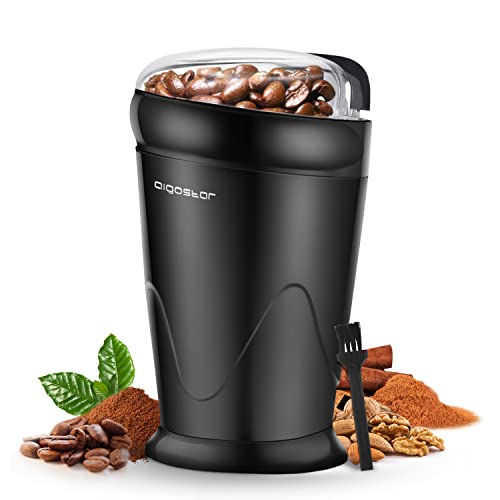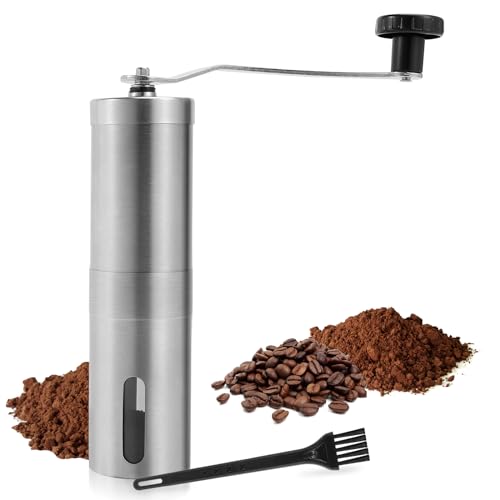9 . What Your Parents Teach You About Ceramic Grinder
2024.11.24 20:03
 The Advantages of a Ceramic coffee grinders makers Grinder
The Advantages of a Ceramic coffee grinders makers GrinderCeramic grinders are well-known for their long-lasting durability and enduring. They are more durable than steel blades, and they won't rust when exposed to warm temperatures. They are not as sharp, however they're not as sharp as stainless steel.
Dual-tool grinding heads are comprised of a ceramic grinding wheel for rough grinding and a flexible grinding wheel for finishing grinding. This new design allows the machining of a shaped surface with varying curvature using a single machine.
Blades with high-strength
The blades are made of a tough material which retains its sharpness for longer than steel. This feature protects the quality of coffee beans, which is a major consideration when choosing a grinder. It helps to ensure that the grind of coffee is consistent, which is vital for a perfect brewing process. This is particularly important when making espresso, as the uneven grind can lead to poor extraction.
The durability of a ceramic grinder makes it easier to clean than other models. Ceramic burrs are not attracted by metal particles or rust. Additionally, non-metal blades don't leave marks on stone or tile surfaces, which could require additional cleaning. Ceramic blades are also less susceptible to corrosion and will not alter the taste of your commercial coffee grinder.
Ceramic blades are a new invention, originally created for industrial processes that required rotating round blades, and later made available to kitchens at home. While these blades are more durable than traditional metal ones, they must be weighed against their increased cost and shorter lifespans. However, the benefits over time of a ceramic blade could be worth the additional cost.
All ceramics begin as powder or clay, which is then mixed with water to form an adhesive. The final shape of the ceramics is then press-molded. The resulting "green" ceramics are soft and difficult to machine, so they are usually fired or "sinterned" in order to make them harder. After that they can be machined with relative ease.
Ceramics are utilized in a variety of manufacturing applications, ranging from semiconductors to surgical instruments. They are usually constructed from zirconia which is extremely sturdy and hard. Zirconia components can be made by a variety of methods including laser cutting and breaking, scribing, and mechanical cutting. The finished pieces can be examined and polished to reveal their internal microstructure. This manner, the exact properties of the ceramic can be determined.
Non-stick coating
The nonstick coating made of ceramic on grinders is a crucial feature for herb enthusiasts, as it prevents the build-up of resin. This coating is also easy to clean, and does not rust like other metals. It is also odorless and long-lasting. It is resistant to chemicals and scratches. However there are many different types of nonstick coatings that are created equal. It is crucial to understand the distinctions between coatings. This includes how many layers are in place and whether or not they are reinforced.
Nonstick coatings are a part of the time of Greek cookware. Archeologists have discovered pots with a coating to prevent dough from sticking. However, the modern nonstick coating was accidentally discovered in 1938 when a Chemours employee named Roy Plunkett accidentally created polytetrafluoroethylene (PTFE). This high-density, heat-resistant chemical compound has a distinctive property: it resists the formation of oil droplets on its surface. It was trademarked as Teflon and began appearing in cookware as early as the 1960s.
Nonstick grinding material is used in a variety of industrial manufacturing processes. This includes form grinding, which is a specialized cylindrical grinding process that creates parts that are precisely the shape of the product that you want. These parts are made of a variety of materials, including Yttria-stabilized Zirconia or Alumina. These materials are inexpensive and have excellent wear resistance and are chemically stable.
Ceramic grinding tools can also help to regulate the heat produced during the milling process. A proper cooling system is crucial to keeping the integrity of the workpiece and extending tool life. This is important because excessive heat can cause the structure of the pore structure of the grinding wheel to break and cause an increase in dimensional accuracy.
SLX has developed a V2.5 ceramic nonstick surface for their grinders that performs similar to your typical Teflon frypan. The coating is completely inert and doesn't contain PTF or PFOA. FDA certified safe for contact with food items and comes with a lifetime warranty. The SLX grinders also come with an embossed PTFE patent and lot number for verification.
Easy to clean
Ceramic grinders are simpler to maintain than steel ones, as they don't retain oil and are less susceptible to heat build-up. Ceramic grinders also require regular cleaning to maintain their good working condition. Clean your grinder once a week to avoid creating a sticky mess. This will ensure that it is free of any contaminants and will not affect the flavor or smell of your marijuana.
You should always remove the lid and hopper, and also any removable sealing gaskets. These components should be washed with soapy water that is hot, and then rinsed thoroughly. After washing, you can employ brushes to scrub the burrs as well as the internal areas of your grinder. Rinse and dry your grinder thoroughly to prevent corrosion.
Idealy, you should employ a stiff or paintbrush to get rid of the stubborn gunk in the difficult-to-access areas of your grinder. After you finish, use a vacuum cleaner or hose attachment to soak up the remaining residue. Be careful not to pick up any screws or parts of your grinder. When you're done, your grinder will look like new.
If you don't have a vacuum cleaner or brush you can boil your metal grinder to cleanse it. Fill a pot up with warm milk, and bring it up to 150 degrees Fahrenheit. If the temperature is at the right then submerge your steel grinder in the milk. After an hour, pull out the grinder and scrub it with a toothbrush. Then, rinse it off with hot water that is clean and let it dry completely prior to using it again.
If you don't want use chemical solutions to dry your grinder, use the back of an AC unit or hair dryer. Be sure to clean the hopper, bin, and body with a lint-free cloth. Avoid using the blower's nozzle near moving parts because it could cause melting of paint or plastic. You can also employ a commercial grinder cleaning solution such as those used by coffee shops, to reduce the oily residue.
Durable
Ceramic grinders are not rusty and are not susceptible to corrosion. Ceramic is also renowned for its high hardness, making it ideal for use in grinding applications that require precision. This is why ceramic grinders are highly sought-after by home cooks and professional baristas. They are also cheaper than stainless steel grinders, making them a good choice for budget-conscious buyers.
The longevity of a grinder made of ceramic is greatly dependent on the kind of construction. The material used to make the blades will determine the length of time they last and how sharp they are. It is essential to choose the right ceramic grinding machine that has high-quality stones that are properly seated within the grinder. It is also crucial to keep your grinding wheels cool and clear of any debris by using cutting and lubrication fluids. Ceramics can be damaged through heat, so it is recommended to select a low speed setting to reduce friction.
Ceramic burrs also have a lower thermal conductivity than stainless steel ones. This helps the grinding process maintain the desired flavor profile by reducing the risk of overheating which can harm delicate coffee compounds. Additionally they are more resistant to wear and tear, allowing them to retain their sharp edge longer.
Additionally, ceramic grinders produce fewer fines and retain less oils, which results in cleaner grinding and less buildup of residue on the grinder. This makes them easier to clean and substantially reduce maintenance costs compared to steel grinders.
Another benefit of a ceramic grinder is that it is able to withstand higher temperatures than stainless steel, making it a perfect option for areas that have a wide range of temperatures. This benefit is especially beneficial for espresso-based drinks that are typically prepared at higher temperatures than other varieties of coffee machine grinder.
 Both kinds of grinders have advantages however it is important to weigh the pros and cons of each. Grinders made of stainless steel are typically cheaper and offer a premium feel. However, they can get duller or damaged over time, leading to more expensive maintenance costs. Ceramic burr grinders are long-lasting and provide an even amount of grind, but they are more expensive initially.
Both kinds of grinders have advantages however it is important to weigh the pros and cons of each. Grinders made of stainless steel are typically cheaper and offer a premium feel. However, they can get duller or damaged over time, leading to more expensive maintenance costs. Ceramic burr grinders are long-lasting and provide an even amount of grind, but they are more expensive initially.